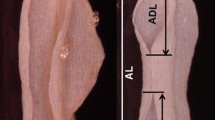Summary
Mesocotyl length is an important character in promoting seedling emergence of direct-seeded rice. Genetic analysis of rice mesocotyl length was conducted using a six parent diallel cross. Generation mean analysis was carried out on parents (P), F1, F2 and backcrosses (B) of three crosses to complement the genetic information from the diallel analysis. Both analyses demonstrated the presence of significant additive and dominance effects. Duplicate type of non-allelic interaction was detected by the generation mean analysis and two crosses showed significant negative dominance gene effect. Dominance was partial and the narrow sense heritability estimate for mesocotyl length was high, indicating the preponderance of the additive effects.
Mesocotyl length was negatively but weakly correlated with the coleoptile length and length of the second internode L2. There was no correlation between mesocotyl length and other mature plant characters such as plant height and internode lengths L1, (L1 being the peduncle with subsequent internodes to the base of the plant). Selection for mesocotyl length can therefore be carried out independent of these plant characters and semidwarf rice varieties with long mesocotyl can be developed.
Similar content being viewed by others
References
Aquino, R.C. & P.R., Jennings, 1966. Inheritance and significance of dwarfism in an indica rice variety. Crop. Sci. 6: 551–554.
Cavalli, L.L., 1952. An analysis of linkage in quantitative inheritance. pp 135–144, In: Reeve, E.C.R. and C.H., Waddington (Eds.) Quantitative Inheritance. HMSO, London.
Falconer, D.S., 1981. Introduction to Quantitative Genetics 2nd edn. Roland Press Company. New York, 340 p.
Foster, K.W. & J.N., Rutger, 1978. Inheritance of semidwarfism in rice (Oryza sativa L.). Genetics 88: 559–574.
Hayman, B.I., 1954. The analysis of variance of diallel tables. Biometrics 10: 235–244.
Hayman, B.I., 1958. The theory and analysis of diallel crosses: Genetics, 43: 63–85.
Hayman, B.I., 1960. The separation of epistatic from additive and dominance variation in generation means. Heredity 12: 371–390.
Jennings, P.R. & R.M., Herrera, 1968. Studies on competition in rice. II Competition in segregating populations. Evolution 22: 332–336.
Jinks, J.L., 1954. The analysis of continuous variation in a diallel cross of Nicotiana rustica varieties. Genetics 39: 767–788.
Jinks, J.L., 1956. The F2 and backcross generations from a diallel cross of Nicotiana rustica varieties. Heredity 10: 1–30.
Jinks, J.L. & R.M., Jones, 1958. Estimation of the components of heterosis. Genetics 43: 223–234.
Jinks, J.L., J.M., Perkins & E.L., Breese, 1969. A general method of metrical traits. II Application to inbred lines. Heredity 24: 45–57.
Mahmud, I. & H.H., Kramer, 1951. Segregation for yield, height and maturity following a soybean cross. Agron. J. 43: 605–609.
Mather, K. & J.L., Jinks, 1982. Biometrical Genetics, (3rd edn), Chapman and Hall, London, 396 p.
Mather, D.E. & V.W., Poysa, 1983. Griffing and Hayman diallel analyses of protein and lysine content of spring triticale. Can. J. Genet. Cytol. 25: 384–389.
Mckenzie, K.S. & J.N., Rutger, 1986. A new semidwarf mutant in a long grain rice cultivar. Crop. Sci. 26: 81–84.
Mckenzie, K.S., J.N., Rutger & M.L., Peterson, 1980. Relation of seedling vigor to semidwarfism, early maturity and pubescence in closely related lines. Crop Sci. 20: 169–172.
Mckenzie, K.S., F.N., Lee & B.R., Wells, 1982. Summary of 1981 Arkansas rice performance test. Arkansas Farm Res. 31: 3.
Terao, H., 1986. Studies on the mesocotyl elongation of seedlings in Japanese paddy rice (Oryza sativa L.) Bull Inst. Trop Agr. Kyushu Univ. 9: 17–87.
Thomas, W.T.B. & C.R., Tapsell, 1983. Cross prediction studies on spring barley 1. Estimation of genetical and environmental control of morphological and maturity characters. Theor. Appl. Genet. 64: 345–352.
Turner, F.T., C.C., Chen & C.N., Bollich, 1982. Coleoptile and mesocotyl lengths in semidwarf rice seedlings. Crop. Sci. 22: 43–46.
Warner, J.N., 1952. A method for estimating heritability. Agron. J. 44: 427–430.
Warner, D.J. & S., Horner, 1980. Inheritance of leaf geometry in cauliflower. The Journal of Heredity 71: 105–109.
Author information
Authors and Affiliations
Rights and permissions
About this article
Cite this article
Mgonja, M.A., Ladeinde, T.A.O. & Aken'Ova, M.E. Genetic analysis of mesocotyl length and its relationship with other agronomic characters in rice (Oryza sativa L.). Euphytica 72, 189–195 (1993). https://doi.org/10.1007/BF00034157
Received:
Accepted:
Issue Date:
DOI: https://doi.org/10.1007/BF00034157




